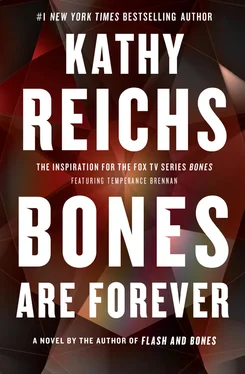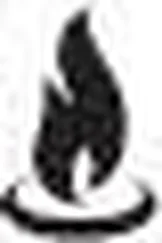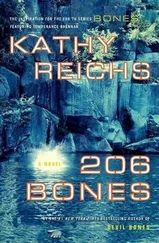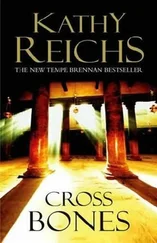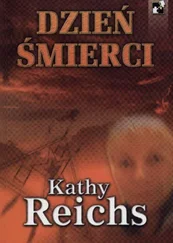We were standing there, mute with disappointment, when the bathroom door opened. We all turned.
Devereaux’s hair was combed and sprayed into a blond updo, and her face was a Gauguin palette of color. Green and lavender lids. Rose cheeks. Red lips. Had her situation not been so sad, I might have found it comical. Like Toddlers & Tiaras .
Ignoring us, Devereaux crossed the room, dropped to her knees, and yanked a suitcase from under the bed. With angry movements, she began tossing in clothing from the shelves and floor. No folding or layering. A wrinkle-free look was not a priority.
Lowering my voice, I told Ollie and Ryan what I’d seen behind the suitcase in the closet.
“The panel is removable?” Ryan asked.
“I think so.”
“May provide access to the bathroom pipes,” Ryan said.
“You’re thinking another dead baby?” Ollie’s expression was grim.
My gaze slid to Devereaux. She was emptying a dresser drawer, oblivious to our conversation.
I nodded.
Wordlessly, we returned to the closet. Ollie and I watched as Ryan dragged the suitcase from behind the clothes.
The panel was approximately twelve inches square, attached to the wall by nails at the corners.
My eyes did a three-sixty. Landed on a pair of orange stiletto pumps. I grabbed and handed one to Ryan.
Hooking the tip of the heel onto the edge of the panel, Ryan pulled with the body of the shoe. The nails slid free with little resistance.
It was Saint-Hyacinthe all over again. I held my breath as Ryan inserted his fingers, levered downward, and pulled the panel free. The opening gaped black and foreboding.
Ollie produced a penlight. Ryan thumbed it on and aimed the beam into the darkness. As expected, the tiny white oval landed on pipes. They were dark and wrapped with frayed insulation.
I watched the oval probe. It crawled up a vent stack. Over a flange. Left across a horizontal.
Banging down the hall told me Devereaux was checking the kitchen drawers and cabinets.
Banging in my ears told me my pulse had gone apeshit.
The oval doubled back, continued to the right, then started probing downward.
Seconds passed. Eons.
And there it was. Jammed in the hollow of a U-shaped trap.
I felt sick to my stomach.
The towel was blue with a small appliqué on one side. It was tightly rolled, with the thick end pointing our way.
“Call the ME?” Ryan asked.
Ollie shook his head. “Let’s be sure. Don’t want to bring a doc out here for nothing.”
A voice in my head was rejecting the brutal reality of the visual input. No, God, no!
Ryan set the penlight on the floor and took a series of shots with his iPhone. Checked the results. “Got it.”
As I kicked aside clothing to clear floor space, Ryan reached in and removed the bundle. Both men looked at me. I dropped to my knees and took a steadying breath.
The fabric was degraded and easily torn. The layers were tightly adhered, sealed by fluids that had long ago dried and congealed. My fingers trembled as I tried to gain entry without doing damage.
The world went deadly quiet, all sound obscured by emotions inside me.
Finally the terry cloth yielded. I rolled the bundle sideways.
The bones were small and brown and curled around a fragmented skull.
“Jesus Christ!”
I looked up.
Ollie’s face was the color of oatmeal. I realized he hadn’t seen the other dead infants.
Moving as gently as possible, I rewound the towel.
“That’s four that we know of.” Ryan was using the light to make one last round in the opening.
“This murdering bitch left a trail of dead babies from Quebec to Alberta! And we can’t find her sorry ass?” Fired by loathing, Ollie’s words came out way too loud.
Ryan got to his feet. “We’ll find her.”
I rose and placed a calming hand on Ollie’s arm.
“Call the ME,” I said.
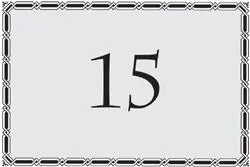
BY ONE-THIRTY RYAN AND I WERE SUITED UP AND STANDING beside a stainless-steel table with Dr. Dirwe Okeke, one of the Alberta ME’s newest hires. Okeke had done his prelims—photos, X-rays, measurements, descriptive observations. I’d done a little dry-brush cleaning and arranged the baby’s bones in anatomical position.
Rather than a pathologist, Okeke looked like he played defensive tackle for Edmonton High, and parents of opposing teams wouldn’t have demanded a birth certificate. He stood six-two, weighed 250. Had I seen him on the street, I’d have put his age at maybe eighteen.
When I’d phoned the ME office, a receptionist had listened to my story, then rolled my call to Okeke. He hadn’t interrupted as I’d introduced myself and explained the dead babies in Quebec and the one at Susan Forex’s house.
As expected, Okeke elected to visit the scene personally. He arrived in an Escalade with a front seat specially outfitted to accommodate whales. Two techs followed in a van.
When she saw Okeke, Devereaux’s attitude did a rapid 180 to meek. I couldn’t blame her. The good doc looked like he was of another species, huge and dark to her small and pale. Without moving or speaking, Okeke seemed to fill her wee bedroom to overflowing.
Okeke had asked few questions, viewed the tiny bones in silence. Then he’d interviewed Devereaux, who swore she knew zip. She hadn’t met Ruben, had never had reason to pry the panel from the wall.
Forex also knew nothing. Or so she claimed. Her shocked expression suggested she was probably being straight.
Ollie had waited for Devereaux to stuff her closet sparklies into the second suitcase, then he drove her to a women’s shelter. I suspected the gesture came partly out of compassion but mostly out of a desire to avoid an up-close-and-personal with the bones of a newborn.
Ryan, Okeke, and I had watched the techs enlarge the opening with a handheld power saw, then search inside the wall. Other than a nest of startled roaches, their efforts produced zilch.
Leaving the techs to photograph and process the scene, Okeke transported the remains in the Escalade. Ryan and I rode with him to the ME office on 116th Street. On the way, we learned that Okeke was from Kenya and that he studied medicine in the UK. That was it. The guy wasn’t a talker.
And here we were.
As with the Saint-Hyacinthe attic baby, nothing was left of this infant but a skeleton and fragments of desiccated tissue. Lacking flesh to hold it together, the skull had fallen apart. The individual cranial bones lay spread like an illustration in an anatomy text.
“Please clarify.” Okeke’s voice was deep, with a Masai Mara lilt reshaped by years of British schooling.
“The baby was at least seven gestational months at the time of its death.”
“Not full-term?”
“It may have been. If so, it was in a very low percentile for size. But the fetus was definitely viable.”
As I explained my measurements and observations, Okeke jotted notes. The clipboard looked like a child’s toy in his enormous hands. “Gender?”
“I can’t determine that from the bones.”
When Okeke nodded, the scalp above his neck rippled, then smoothed.
“Trauma?”
“None,” I said. “No fractures or indications of physical abuse.”
More jotting. “Cause of death?”
“The bones and X-rays show no evidence of malnutrition, disease, or deformation.” I thought of the wadded tissue in the throat of the window-seat baby. “No intrusions or foreign objects.”
“What of ancestry?”
“The cheeks may have been quite wide, but it’s hard to tell with nonarticulated bones. And I may have seen slight shoveling on an upper central incisor.”
Читать дальше
